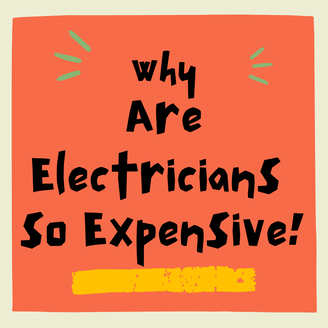Per Forbes magazine, in 2018 Kansas electricians made an average salary of $54,940 ($26.93 an hour based on a 40 hour work week). The cost of an employee to a business is more than the wage paid to the employee. Business must share in paying payroll taxes (FICA & FUTA) and often provide other benefits such as vacation, uniforms or paid training. A rule of thumb used by most businesses is that an employee will cost the business 1.25 to 1.4 times their annual salary. The true cost to a business hiring an electrician at $54,940 is somewhere between $68,675 and $76,916 ($33.66 – $37.70 an hour).
Electricians are in the top five highest paid non-degree professions. For years, society has funneled high school students towards college. With fewer people entering the skilled trades, it has become increasing difficult for businesses to hire qualified workers. Lack of skilled labor has led to high wages. It’s simple supply and demand. Perhaps it is time to teach our children there is nothing shameful about working with your hands and that people going into the trades make as much money as people with college degrees, but without the associated college debt.
Today’s electrician is not your Granddaddy’s electrician who showed up in a rusty truck, pulled a little wire and made up an outlet or a switch. Almost everything installed by an electrician today is a “smart” device which means it has to be programmed and comes with a remote or a phone app. Being an electrician has always required a strong mathematical background. Now, electricians must know some basics of computer programming and are constantly needing to learn a variety of new technology from installing solar panels to generators. If you think it’s difficult to wire a three way switch in your home, try troubleshooting a complex control system.
Electricians do not have a four year degree but they are required to complete either a four year on the job apprenticeship or a combination of two years of advanced technical schooling and a two year apprenticeship prior to being able to take the test to become a licensed Journeyman. While apprentices earn a salary during their apprenticeship, it takes years of training before they can qualify as an electrician. I like calling it a “Field Degree”.
However, paying an employee is not the only cost to a business. Your electrician likely arrived in a specially designed, shiny service vehicle which averaged somewhere between $32,000 – $45,000 to purchase. If payments are $7200 a year, $600 month), the vehicle cost to the business is around $3.50 an hour based on an average 2,080 hours of use during a year.
In addition to wages and the price of purchasing service vehicles, electrical contractors must calculate their “rolling overhead”. This term refers to the cost of keeping a service truck operating in the field but doesn’t include the price of the truck. These expenses include fuel, maintenance costs, taxes, GPS tracking, insurance, signage, racks, tools, test equipment and a large inventory of parts. My service trucks carry on average of $10,000 in inventory. A typical rolling overhead cost per vehicle is easily in the $700 – $1,000 a month range or around $4 – $6 per hour operated.
Isn’t that enough to calculate? No, now your Electrical Contractor must calculate his “base overhead” which is the cost of running his office. These expenses include the cost of maintaining a shop including monthly mortgage, repairs to the building, insurance, taxes, utilities, administrative office staff salary and benefits, general liability insurance, website, landline and cell phone expense, advertising, IT support, desks, furniture, computers, internet, cleaning, credit card fees, licenses, customer management and accounting programs, professional fees, association fees, collection fees, right on down to basic office supplies such as paperclips and pens.
A company’s base overhead is likely its largest expense. I remember the first time I calculated my “base overhead”. I thought, “That can’t be right”. I refigured it and yes, it was right. The base overhead is typically the highest of the four major categories and depending on your contractor’s expenses may be in the $40 – $60 an hour range.
So to recap:
Wages $ 35
Rolling Overhead $ 5
Base Overhead $ 45-50
Total $ 88-93
So, if your Electrical Contractor is charging you a paltry $100 an hour, he probably gets to keep $6 to $11 after his expenses. Of course, this is per employee/service truck. A sole proprietor working out of his house with one truck is simply working for a low wage. I had a friend who was struggling with his small electrical contracting business tell me his accountant had told him that to make a decent profit, he should be charging $140 an hour. Because of a competitive market, he was unable to charge this rate so he ended up working very long hours in order to make a livable salary.
According to the most recent Sage Works Industry Data I reviewed (2018), the average Electrical Contractor made a net profit margin of 5.87%. Other sources quote around a 3% profit margin. It’s no wonder so many businesses fail.
And with the advent of Covid-19, many businesses, including electrical contractors are facing the additional expenses related to providing masks, hand sanitizer and the need for frequent and additional cleaning. So, that profit margin probably just dropped a little more.
This article may not be reproduced in any form without the written permission of CWC Electric, LLC.
Reference Articles:
https://www.forbes.com/sites/andrewdepietro/2019/11/14/electrician-salary-state/#622a376f67de
https://www.sba.gov/blog/how-much-does-employee-cost-you#:~:text=This%20includes%20the%20dollars%20and,range%20from%20%2443%2C750%20to%20%2449%2C000.
https://www.ecmag.com/section/your-business/pricing-service-work-profit
https://www.bls.gov/oes/current/oes472111.htm
https://www.ecmag.com/section/your-business/calculating-net-profit-margins-tricky-business
https://www.ecmag.com/section/your-business/2018-profile-electrical-contractor
https://www.sageworksdatabase.com/


